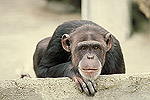| << Chapter < Page | Chapter >> Page > |
| COMMON GENES OF DIFFERENT ORGANISMS WITH HUMANS | % Common with Humans | |
 |
Chimpanzee, Pan troglodytes, 30 000 genesChimpanzees have about the same number of genes as humans. But then why can't they speak? The difference could be in a single gene, FOXP2, which in the chimpanzee is missing certain sections. | 98% |
 |
Mouse, Mus musculus, 30 000 genesThanks to mice, researchers have been able to identify genes linked to skeletal development, obesity and Parkinson's disease, to name but a few. | 90% |
 |
Zebra Fish, Danio rerio, 30 000 genes85% of the genes in these little fish are the same as yours. Researchers use them to study the role of genes linked to blood disease such as anemia falciforme and heart disease. | 85% |
 |
Fruit Fly, Drosophila melanogaster, 13 600 genesFor the past 100 years, the fruit fly has been used to study the transmission of hereditary characteristics, the development of organisms, and, more recently, the study of changes in behaviour induced by the consumption of alcohol. (Image: David M.Phillips, Visuals Unlimited, Inc.) | 36% |
 |
Thale cress, Arabidopsis thaliana, 25 000 genesThis little plant, from the mustard family, is used as a model for the study of all flowering plants. Scientists use its genes to study hepatolenticular degeneration, a disease causing copper to accumulate in the human liver.(Image: Wally Eberhart, Visuals Unlimited, Inc.) | 26% |
 |
Yeast, Saccharomyces cerevisiae, 6275 genes You have certain genes in common with this organism that is used to make bread, beer and wine. Scientists use yeast to study the metabolism of sugars, the cell division process, and diseases such as cancer. (Image: Kessel&Shih, Visuals Unlimited, Inc.) | 23% |
 |
Roundworm, Caenorhabditis elegans, 19 000 genes Just like you, this worm possesses muscles, a nervous system, intestines and sexual organs. That is why the roundworm is used to study genes linked to aging, to neurological diseases such as Alzheimer's, to cancer and to kidney disease. | 21% |
 |
Bacterium, Escherichia coli, 4800 genes The E. coli bacterium inhabits your intestines. Researchers study it to learn about basic cell functions, such as transcription and translation. (Image: Fred Hossler, Visuals Unlimited, Inc.) | 7% |
Genes are maintained over an organism's evolution; however, genes can also be exchanged or taken from other organisms. Bacteria can exchange plasmids carrying antibiotic resistance genes through conjugation, and viruses can insert their genes into host cells. Some mammalian genes have also been adopted by viruses and later passed onto other mammalian hosts. Regardless of how an organism gets and retains a gene, regions essential for the correct function of the protein are always conserved. Some mutations can accumulate in non-essential regions; these mutations are an overall history of the evolutionary life of a gene.
However, all living organisms do have ancient genes stemming from the beginning of time that humans share with every living organism. So, if humans have so much in common with other species, what is it that defines being human? What is it that turns humans into this complex being capable of learning, speaking, thinking and feeling? What is it that makes humans different from each other?

Notification Switch
Would you like to follow the 'Genetics' conversation and receive update notifications?